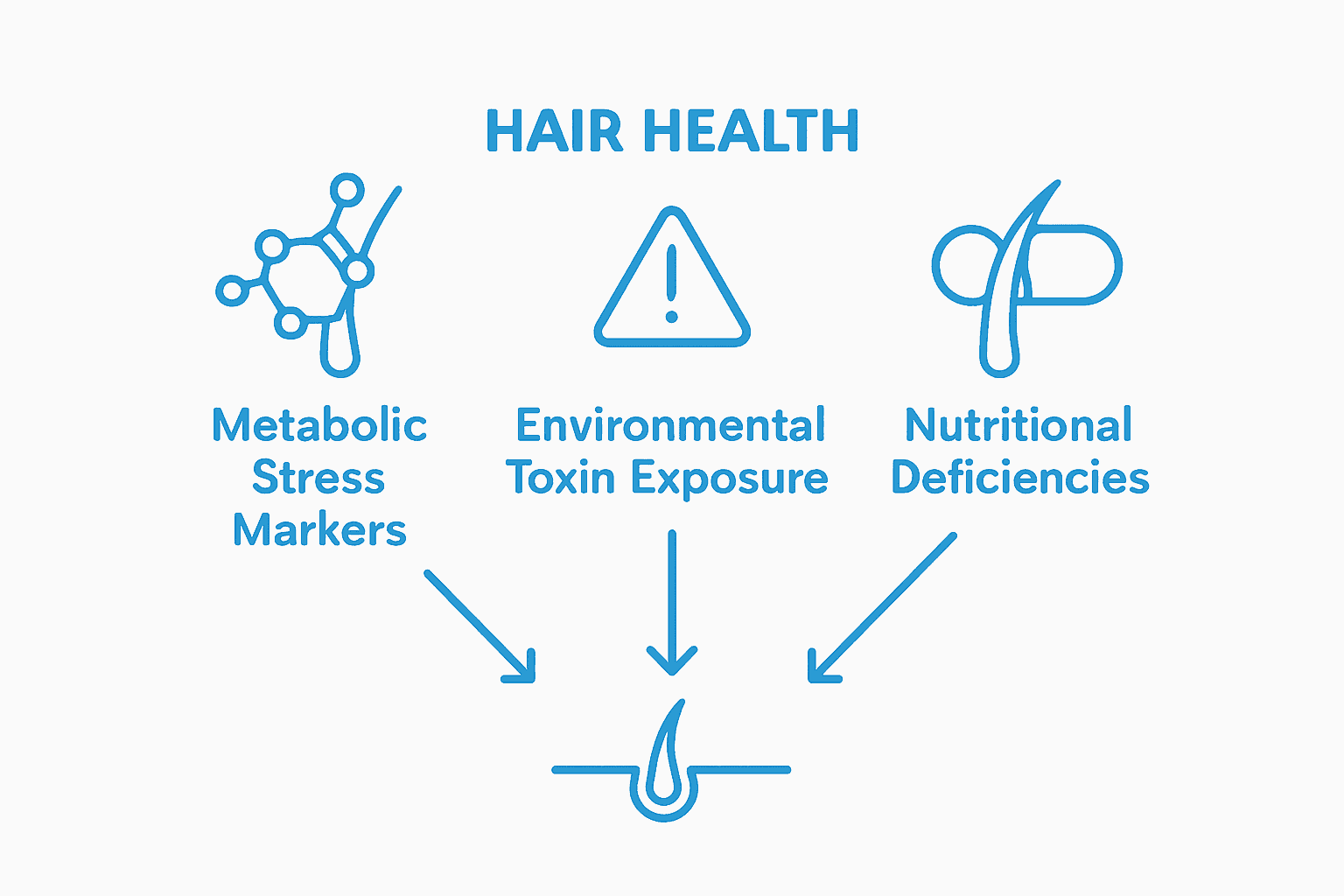Blog
Learning Materials
Understanding Hair Analysis for Hair Loss: What You Need to Know
Updated: September 27, 2025

Hair loss has become a growing concern for millions of adults and some reports reveal that up to 50 percent of men and women experience noticeable thinning by age 50. Most people think hair analysis just means looking at your scalp under a bright light. Yet science now lets experts examine each strand for hidden clues about your nutrition, hormones, and even environmental exposures. This tiny sample often reveals more about your health history than a standard checkup ever could.
Table of Contents
- What Is Hair Analysis For Hair Loss?
- The Importance Of Hair Analysis In Understanding Hair Loss
- How Hair Analysis Works: Techniques And Approaches
- Key Concepts In Hair Analysis For Effective Solutions
Quick Summary
| Takeaway | Explanation |
|---|---|
| Hair analysis reveals key health indicators | This diagnostic tool uncovers nutritional deficiencies, hormonal imbalances, and genetic predispositions affecting hair health. |
| Personalized treatment strategies are essential | Tailored approaches based on individual biological profiles improve effectiveness in treating hair loss compared to generic methods. |
| Meticulous sample collection enhances accuracy | Collecting hair from specific scalp regions using sterile techniques ensures reliable results in hair analysis. |
| Advanced techniques provide deeper insights | Methods like mass spectrometry detect trace elements, revealing metabolic patterns and environmental influences on hair health. |
| Understanding root causes is crucial | Focusing on underlying mechanisms of hair loss allows for effective interventions and promotes overall scalp wellness. |
What is Hair Analysis for Hair Loss?
Hair analysis for hair loss represents a sophisticated diagnostic approach that provides comprehensive insights into an individual's hair health and potential underlying causes of hair thinning or loss. Discover advanced hair diagnostic techniques through modern scientific methodologies that go far beyond traditional visual assessments.
The Science Behind Hair Analysis
Hair analysis is a non invasive diagnostic technique that examines hair samples at a microscopic and cellular level to understand the root causes of hair loss. Unlike simple visual observations, this method involves detailed scientific evaluation of hair follicle structure, composition, and potential stress indicators.
Researchers from Harvard Medical School confirm that hair analysis can reveal critical health information by examining:
- Nutritional Deficiencies: Detecting mineral and vitamin imbalances
- Hormonal Patterns: Identifying potential endocrine disruptions
- Genetic Predispositions: Understanding inherited hair loss tendencies
Comprehensive Diagnostic Approach
The process of hair analysis involves collecting precise hair samples from specific regions of the scalp, typically the crown or areas experiencing noticeable thinning. These samples undergo meticulous laboratory testing that can uncover complex interactions between genetic factors, environmental influences, and physiological conditions contributing to hair loss.
Professional hair analysis provides a multifaceted understanding of an individual's hair health, moving beyond surface level symptoms to explore the intricate biological mechanisms driving hair growth and potential deterioration. By mapping these detailed insights, individuals can develop targeted strategies for hair restoration and overall scalp wellness.
The Importance of Hair Analysis in Understanding Hair Loss
Hair analysis represents a critical diagnostic tool that transcends superficial observations, providing profound insights into an individual's overall health and potential hair loss mechanisms. Learn more about comprehensive hair diagnostics to understand how advanced testing can transform hair loss management strategies.
Unveiling Hidden Health Indicators
Hair analysis offers a unique window into an individual's physiological landscape, revealing complex health information that traditional medical examinations might overlook. Research from the National Institutes of Health demonstrates that hair samples can provide critical diagnostic signals about metabolic functioning, nutritional status, and potential underlying health conditions.
Key health indicators uncovered through hair analysis include:

- Metabolic Stress Markers: Detecting hormonal imbalances and endocrine disruptions
- Environmental Exposure: Identifying potential toxin accumulations and heavy metal exposures
- Nutritional Deficiency Patterns: Mapping mineral and vitamin imbalances that impact hair health
Precision in Personalized Treatment Strategies
By offering a detailed biological profile, hair analysis enables healthcare professionals to develop highly personalized treatment approaches. This diagnostic method transforms hair loss management from a generalized strategy to a targeted, individual intervention. Understanding the specific biological mechanisms driving hair loss allows for more precise medical recommendations, potentially preventing further hair deterioration and promoting targeted regeneration strategies.
The comprehensive nature of hair analysis means that patients receive not just a diagnosis, but a holistic understanding of their unique physiological challenges, empowering them to make informed decisions about their hair and overall health.
Below is a table summarizing the primary health indicators that can be revealed by hair analysis, helping to clarify what each indicator may reflect about overall wellness.
| Health Indicator | What It Reveals |
|---|---|
| Metabolic Stress Markers | Signs of hormonal imbalance, endocrine disruptions |
| Environmental Exposure | Potential toxin and heavy metal accumulation |
| Nutritional Deficiency Pattern | Mineral and vitamin imbalances impacting hair health |
| Hormonal Patterns | Underlying endocrine system irregularities |
| Genetic Predispositions | Inherited tendencies toward hair loss |
| Biochemical Profiling | Detailed metabolic and hormonal interactions |
How Hair Analysis Works: Techniques and Approaches
Hair analysis represents a sophisticated scientific method that transforms a simple hair sample into a comprehensive diagnostic tool. Explore personalized hair health tracking and understand the intricate techniques used by professionals to decode complex health signals.
Sample Collection and Preparation
Research from the National Institutes of Health reveals the meticulous process of hair sample preparation involves precise collection techniques that ensure accurate diagnostic results. Professionals typically collect hair samples by:
- Location Specificity: Extracting samples from specific scalp regions to minimize variability
- Contamination Prevention: Using sterile techniques to avoid external interference
- Representative Sampling: Collecting multiple strands to create a comprehensive profile
The collected hair undergoes rigorous preparation, which includes careful washing to remove external contaminants and specialized laboratory processing techniques that enable detailed microscopic and chemical analysis.
This table outlines the major steps and features involved in the hair analysis process, providing an overview of how samples are collected and evaluated to ensure accurate diagnostic results.
| Step | Main Feature/Requirement |
|---|---|
| Sample Location Specificity | Hair is collected from designated scalp regions |
| Contamination Prevention | Sterile techniques minimize external interference |
| Representative Sampling | Multiple strands create a comprehensive hair profile |
| Washing & Preparation | Removal of external contaminants before analysis |
| Laboratory Testing | Microscopic and chemical analysis of prepared samples |
| Advanced Analytical Methods | Use of mass spectrometry and spectroscopy for precision |
Advanced Analytical Methodologies
Modern hair analysis employs multiple sophisticated techniques to extract comprehensive health insights. Spectroscopic methods, such as inductively coupled plasma mass spectrometry, allow scientists to detect minute mineral and trace element concentrations with exceptional precision. These advanced approaches enable detailed examination of metabolic patterns, nutritional status, and potential environmental exposures that traditional medical tests might miss.
By integrating multiple analytical approaches, hair analysis transforms a simple strand of hair into a powerful diagnostic tool that provides unprecedented insights into an individual's physiological health landscape. This approach moves beyond superficial observations, offering a nuanced understanding of complex biological interactions that influence hair health and overall wellness.
Key Concepts in Hair Analysis for Effective Solutions
Hair analysis represents a sophisticated approach to understanding hair loss, providing insights that go beyond traditional diagnostic methods. Explore advanced hair restoration strategies to comprehend how targeted interventions can transform hair health management.
Diagnostic Precision and Comprehensive Assessment
Clinical research confirms that integrating hair analysis with comprehensive medical assessment dramatically enhances the accuracy of hair loss diagnosis. This multifaceted approach allows healthcare professionals to develop nuanced treatment strategies that address root causes rather than merely managing symptoms.
Key diagnostic considerations in hair analysis include:
- Biochemical Profiling: Mapping intricate metabolic and hormonal interactions
- Genetic Markers: Identifying inherited predispositions to hair loss
- Environmental Impact Assessment: Understanding external factors influencing hair health
Personalized Treatment Framework
The true power of hair analysis lies in its ability to create highly individualized treatment pathways. By examining detailed biological markers, medical professionals can craft interventions that specifically target an individual's unique physiological characteristics. This approach moves beyond generic treatments, recognizing that hair loss is a complex condition influenced by multiple interconnected biological systems.
Understanding these intricate relationships enables more precise, targeted interventions that address the underlying mechanisms of hair loss. The goal is not just to halt hair deterioration but to promote optimal scalp health and potential hair regeneration through scientifically informed strategies.

Discover Insights That Transform Your Journey to Fuller Hair
Are you struggling to make sense of your hair loss and feel overwhelmed by technical details like nutritional deficiencies or hormonal patterns discussed in the article? You are not alone. Many people face uncertainty and frustration when trying to understand the science behind hair analysis and what it means for their unique situation. The pain of watching your hair thin can feel isolating, but clear answers are within reach.

Now is the time to take control. MyHair.ai offers a practical and personalized solution that puts the power of advanced hair health analysis in your hands. Upload your own scans and benefit from comprehensive assessments designed to decode your hair’s story. Visit MyHair.ai and experience tailored recommendations that give you actionable steps based on science, not guesswork. Start your journey toward healthier, more confident hair — see real change by acting today.
Frequently Asked Questions
What is hair analysis for hair loss?
Hair analysis for hair loss is a diagnostic method that examines hair samples at a microscopic level to uncover the underlying causes of hair thinning or loss, including nutritional deficiencies, hormonal patterns, and genetic predispositions.
How does hair analysis work?
Hair analysis involves collecting hair samples from specific areas of the scalp, followed by rigorous laboratory testing to assess hair follicle structure, composition, and potential stress indicators, thus providing a detailed understanding of an individual's hair health.
Why is hair analysis important for understanding hair loss?
Hair analysis is important because it reveals complex health information that other diagnostic methods might overlook. This comprehensive approach allows for the identification of metabolic stress markers, nutritional deficiencies, and environmental factors that contribute to hair loss.
What can hair analysis reveal about my overall health?
Hair analysis can reveal critical health indicators such as hormonal imbalances, nutritional deficiencies, and environmental exposures, offering insights into metabolic functioning and potential underlying health conditions that may be affecting your hair health.
Recommended
- Hair Loss Clinic: Diagnosis, Treatment, and Prevention | MyHair | MyHair
- Effective Hair Fall Problem Solution: Regain Your Confidence | MyHair | MyHair
- How to Reverse Balding: Effective Solutions for Hair Regrowth | MyHair | MyHair
- Normal Hair Fall: What to Expect and When to Worry 2025 | MyHair | MyHair